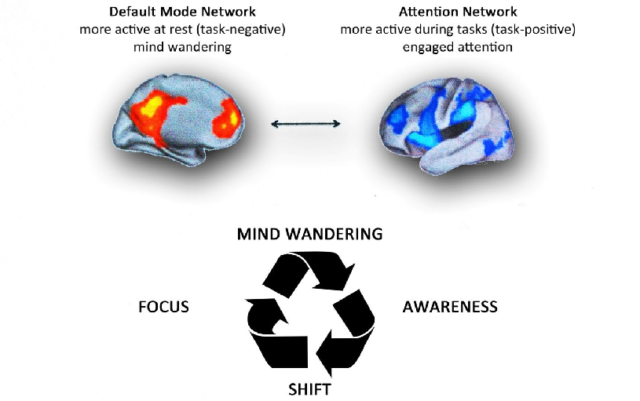Mind wandering around the hills of Úbeda

Mental wandering, sometimes referred to as off-task thinking or, colloquially, going on autopilot, is the experience of thoughts not staying on a single topic, but jumping without control from one thing to another. This is particularly striking when we are engaged in a task that requires focus.
A common place for mental wandering is when we are driving a familiar route. The trip becomes an almost automatic activity that may require minimal use of the task-positive network, the brain circuitry that is activated when engaged in a particular activity that demands attention. In situations where stress is low, people do not remember what has happened in the environment, how they got home, because they were occupied with their thoughts. This is known as the disengagement hypothesis in which mental wandering is thought to reduce cortical processing of the external environment. When thoughts are unrelated to the task at hand, the brain processes both task-relevant and task-irrelevant sensory information in a less detailed way.
Neuroscientists argue about whether letting the mind go is a good thing or not. Until not so long ago, the general opinion was that letting the mind wander had a negative impact and made us unhappy. However, other scientists claimed that our mind wanders for about half of the time we are awake, and it makes no sense that such a common component of our brain’s functioning, and with such a high energy cost – the brain consumes 20% of our body’s energy – would be unproductive, counterproductive or even harmful.

Kam and her group at UC Berkeley have designed a system to track our thoughts and determine whether they are focused on a task or wandering 1. They have found that the mind rarely sits still when left alone, but trains of thought can unfold in very different ways. The research group combined electrophysiological recording with sampling of 39 adults to assess mental activity in four types of thoughts: task-related, free, deliberately constrained, and automatically constrained. They then gave them tedious tasks and measured their brain activity with an EEG, a machine that records their brain waves using electrodes placed on the head. When the participants completed the boring tasks, they rated their thoughts on a scale of 1 to 7, reporting whether their thoughts were about the task, freely moving, deliberately constrained, or automatically constrained. The researchers then matched the responses with recordings of brain activity. The brain signals were different: the P3 wave of the parietal cortex, the lateral area of the brain, was higher for task-related relative to non-task-related thoughts, while the frontal P3 of the frontal cortex, the rostral area of the brain, increased for deliberately constrained compared to unconstrained thoughts. Increased frontal alpha power was observed during free-motion thoughts compared to non-free-motion thoughts. Alpha power variability increased for non-task, free-motion, and unconstrained thoughts. These findings indicate that the four types of thoughts have distinct electrophysiological signatures, suggesting that the method employed captures the heterogeneity of our ongoing thoughts. From their results, the researchers concluded that mental wandering is an important cognitive process, is good for us, and can lead to new ideas or innovations.
On the more critical side of the mind wandering debate, the Track Your Happiness project, part of Matt Killingsworth’s predoctoral research at Harvard University, concluded that mind wandering makes us unhappy 2 . Killingsworth used an iPhone app that captured the user’s feelings in real time. The tool prompts the user at random times and asks, “How are you feeling right now?” and “What are you doing right now?” Analysis of those responses suggested that mental wandering was much more typical in everyday activities than in controlled laboratory settings. They also saw that people were less happy when their minds were wandering than when they were otherwise occupied. This effect was offset to some extent by people’s tendency to ramble on happy topics, but unhappy mental wandering was more likely to be rated as more unpleasant than other activities. Unhappy moods can also elicit mental wandering, but the time lag between mental avoidance and mood suggests that mental wandering itself can also elicit negative moods. In addition, research suggests that subjects participating in experiments report more mental wandering when they are bored, stressed, or unhappy.
Mental wandering has been associated with possible traffic accidents, low mood problems or depression, and alcohol intoxication. Killingsworth’s data showed that our mind wanders 47% of the time, but that it almost always wanders to negative thoughts and gets stuck in rumination. For example, his data showed that commuters are happier if they concentrate in a traffic jam than if they let their mind wander. That negative image of mind wandering surprises to creatives and innovators who use this mental process to solve difficult problems or generate new ideas. Zachary Irving, assistant professor at the University of Virginia and part of Kam’s team, distinguishes between guided attention, unguided attention and rumination and proposes that mind wandering be understood as “unguided attention.” Attention would be guided if it is redirected and refocused when distracted from its current goal. In contrast, in mind wandering our thoughts wander from one subject to another, without control or constraint, and are therefore unguided. Mind wandering may seem purposeless, but our thoughts tend to focus on our goals. Irving calls this the “Purposeful Wandering Puzzle” since on the one hand mind wandering is purposeless and unguided, but it is often caused, and therefore motivated, by our goals. Irving believes this is very different from rumination, during which we focus obsessively on our distress. He suggests that rumination is not mental wandering at all, but a type of guided attention because the brain resists distraction from it.
Kam’s research group was very positive about their results. As Alison Escalante reported in Forbes magazine from one of the coauthors, “For the first time, we have neurophysiological evidence that distinguishes different patterns of internal thought, allowing us to understand the varieties of thought central to human cognition”.
The results are particularly interesting if we apply them to the school world. The minds of infants and young children seem to wander constantly. The alpha waves that appear when our minds wander mean that we are relaxing. It is believed that our brains cannot maintain concentration and productivity without regular periods of relaxation. Also, another thing that mind wandering does for us, although it may seem counterintuitive, is that letting our thoughts wander can help us solve problems when focusing on them doesn’t work. A free association thought process that randomly generates imaginative memories and experiences can lead you to new ideas and insights. So the next time you want to solve a problem or create something new, maybe you should turn on the alpha waves, relax and let your mind fly.
References
- Kam JWY, ZC Irving, C Mills, S Ptel, A Gopnik, RT Knight (2021) Distinct electrophysiological signatures of task-unrelated and dynamic thoughts. Proc Natl Acad Sci USA 118 (4): e2011796118 doi: 10.1073/pnas.2011796118 ↩
- Escalante A (2021) New Science: Why Our Brains Spend 50% Of The Time Mind-Wandering. Forbes ↩